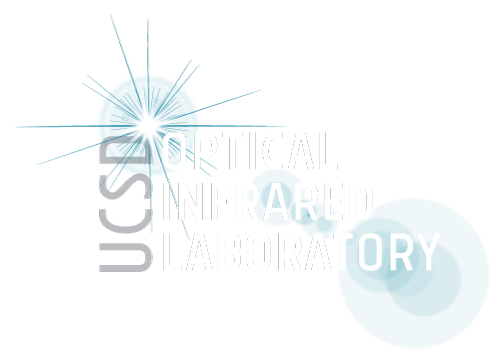| Overview | Science Cases | Simulations | Filters/Gratings | Team | IRIS ETC |
Summary of Science Cases
The combination of a large collecting area and unprecedented angular resolution will have a direct impact on a broad range of science programs that span topics as diverse as the search for extrasolar planets to studies of the first stars to illuminate the Universe. The science team has generated a plethora of astronomical topics that IRIS will be capable of exploring.

Identification and characterization of first light galaxies and population III stars.
Figure on the left is a simulation of a forming galaxy at z=12.5 and the expected hydrogen number density (Johnson, Greif, Bromm 2008). The dense gas (orange-white) just left of the center of the galaxy represents the formation of two Pop III stars. Overlaid on the figure is a 1"x3" field of view (3.6kpc x 10.8kpc), which is close to the FOV using IRIS's 0.025" slicer scale.
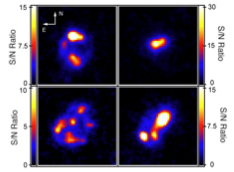
Studying galaxy formation and mass assembly over cosmic time (1 < z <5). Using optical emission lines (e.g., Hα, Hβ, [OIII]) to map 2D dynamics of galaxies during the peak epoch of star formation and AGN accretion.
The anticipated S/N ratios for Hα emission from four high-z galaxies as observed using the IRIS IFS 0.05" spatial sampling (see Law et al. 2006).
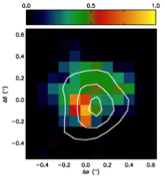
Tracing metallicity over cosmic time (1 < z <5) using multiple optical emission lines to determine the chemical enrichment history. The IFS will be able to map metallicity gradients over individual high-z galaxies from different galactic components (i.e.,bulge, disk, outflows, and inflows.
The figure on the left is a [NII]/Hα ratio map of a z~1.6 galaxy from the Keck AO system, and shows high spatial concentration (yellow) of [NII]/Hα which shows the presence of a weak AGN within this star-forming dominated galaxy (Wright et al. 2009). IRIS will be essential for distinguishing between AGN and star forming emission from different regions of a galaxy.
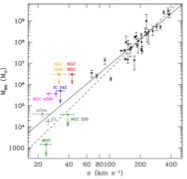
A study of AGN, black hole demographics and growth throughout cosmic history.
The left figure is of the MBH-σ relation plotted for measured black hole masses versus observed dispersions of late-type spirals and nuclear star clusters (Barth et al. 2009). There is a large phase-space regime that requires both higher sensitivity and angular resolution observations of low mass black holes (106 Msun) and high mass black holes (109 Msun). IRIS's finest scale (0.004") is very suitable for this study.
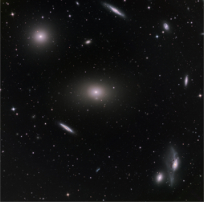
A study of stellar populations in galaxies from the local group to the Virgo cluster. IRIS with its high-angular resolution and sensitivity will be able to produce near-infrared spectra and images of individual stars in nearby galaxies, and will probe the chemical enrichment and formation histories for a range of Hubble types.
A one-degree image of the Virgo cluster (18 Mpc) from HST, with the lenticular galaxy at the center and other spiral galaxies on the outskirts. IRIS will be able to study each of these galaxies to an unprecedented image depth.
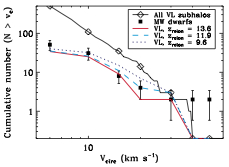
A study of local dwarf galaxy's dynamical and chemical enrichment to probe the dark matter distribution and differing dark matter models (warm vs. cold).
On the left, the cumulative number of Milky Way satellite galaxies as a function of their observed circular velocities (black points). These observations are compared to the Via Lactea N-body simulation of predicted number of satellites and how differing reionization epochs influences the expected satellite number distribution (Simon & Geha 2007).
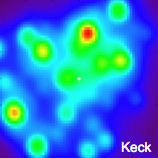
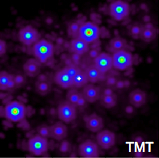
Studying the properties and conditions surrounding the supermassive black hole (SMBH) at the center of the Galaxy.
The relative astrometric accuracy of 30 μas will allow measurements to better constrain MBH, test General Relativity, determine GC distance, and the stellar dynamical history.
Right figure is of the current imaging capabilities of the central arcsecond sources from Keck-AO. The image on the left represents the depth and resolution that TMT and IRIS will provide (see UCLA Galactic Center).
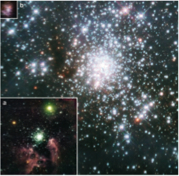
Investigating star formation properties in star clusters: timescale of star formation and efficiencies, initial cluster mass function (ICMF), initial mass function, multiplicity and kinematics.
The figure on the left illustrates three clusters with varying masses (30Dor: 105 Msun, NGC3603: 104 Msun, Orion: 103 Msun) which will be resolved with IRIS at distances up to 20 Mpc away.
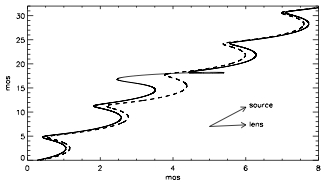
Constraining models of stellar structure and evolution by determining precise stellar masses from astrometric microlensing. IRIS, with its high astrometric relative accuracy, will be able to fit microlens light curves to accurately determine stellar masses for a range of stellar-types.
On the left, a proper motion curve for a star over 5 years that has been lensed (solid curve) and without being lens (dashed lens) (Belukurov & Evans 2002).
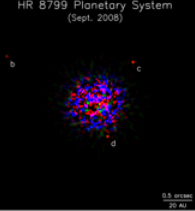
The detection and characterization of extrasolar planets and planet forming environments.
On the left, an image of the first extrasolar multiple planet system ever directly-imaged, around the young star HR 8799 (Marois et al. 2008). The image is a near-infrared color composite of J, H, and K bands taken from both Keck and Gemini telescopes using adaptive optics. Each planet is respectively 70, 40, and 25 AU from the central star. A system such as HR 8799 would be easily studied using IRIS.
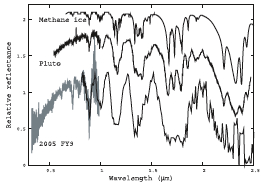
The formation history of our solar system. Using near-infrared spectroscopy for compositional and dynamical studies of Kuiper Belt Objects (KBO) and transneptunian objects (TNOs).
Near-infrared spectra of Pluto and the TNO, 2005 FY9, show strong methane absorption in the figure on the left (Licandro et al. 2006).
Lastly, and perhaps the most intriguing, are the new discoveries that will likely be revealed by IRIS. As is stated in The Exploration of the Unknown by Kellermann el al. 2009, "The excitement of the next generation of astronomical facilities is not in the old questions which will be answered, but in the new questions that they will raise." With IRIS and TMT extending our current technology by orders of magnitude in sensitivity and angular resolution it has the promise of doing just that.
